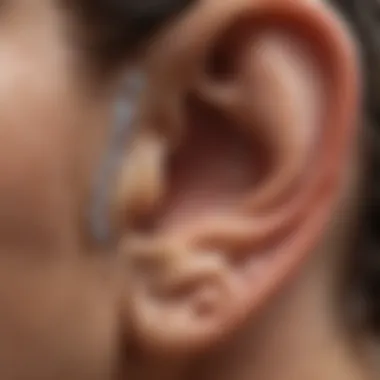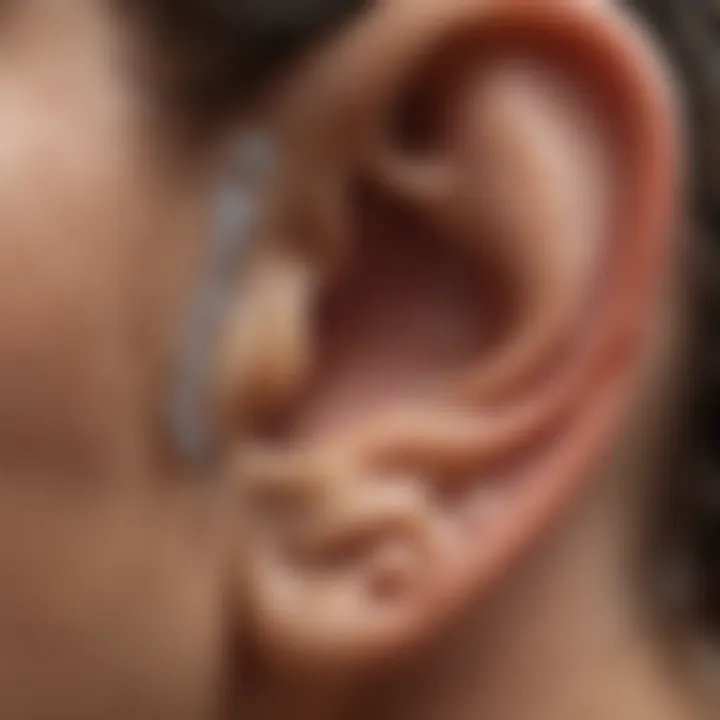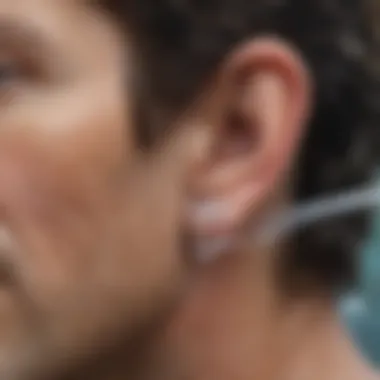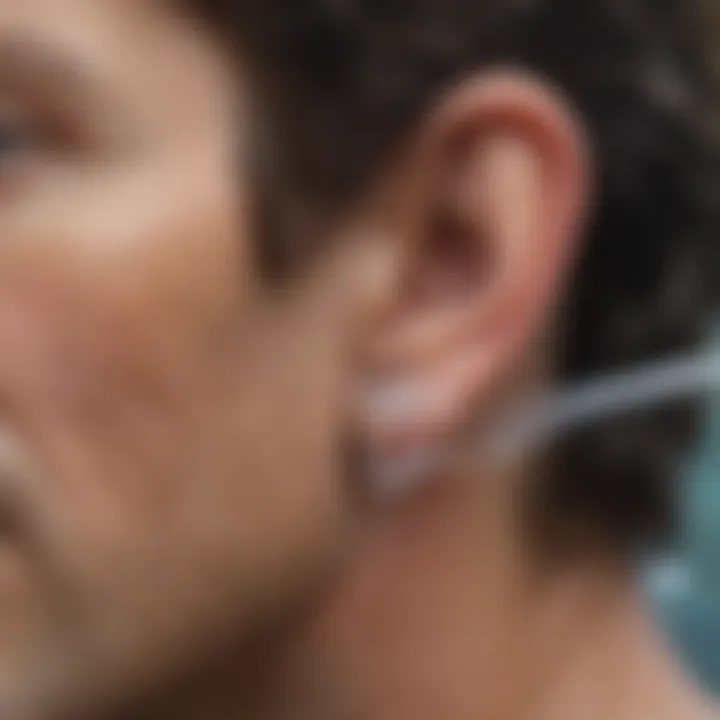Managing Water Blockage in the Ear: Causes and Solutions


Intro
Water blockage in the ear is a common experience, particularly for surfers and those who spend extended time in aquatic environments. This seemingly trivial issue can lead to discomfort, impaired hearing, and sometimes serious infections. Understanding the anatomy of the ear and how water can become trapped provides crucial insight into both prevention and relief.
Many individuals may downplay the severity of a blocked ear, but for surfers or swimmers, this can impact performance significantly. When water gets lodged in the ear canal, it can create a sense of fullness, a drop in hearing ability, and may even lead to annoying sensations like itching or pain.
Let’s delve into the causes and effects of such blockages before shedding light on effective strategies for remediation and prevention.
Understanding Ear Anatomy
Understanding the anatomy of the ear lays a solid foundation for grasping the implications of water blockage. Each part of the ear plays a significant role in how we perceive sound and maintain balance. By dissecting the ear’s structure, we can better comprehend how water intrusion affects its functionality, including hearing capabilities and equilibrium. A clear understanding of these anatomical components is essential for devising effective strategies to address water blockage.
Structure of the Ear
Outer Ear
The outer ear is the part that faces the world. It includes the pinna, which catches sound waves and funnels them into the ear canal. One key characteristic of the outer ear is its curved shape, which helps in directing sound waves efficiently. This is crucial for anyone who enjoys activities like surfing, where auditory awareness is essential for safety and enjoyment. A unique feature of the outer ear is its ability to protect the inner structures from debris and moisture, although it is not entirely foolproof against water getting trapped. This can sometimes be a disadvantage for swimmers, as water can accumulate in the ear canal, leading to discomfort and possible hearing issues.
Middle Ear
Moving deeper, we encounter the middle ear, which contains tiny bones known as ossicles. These bones help amplify sound vibrations from the outer ear to the inner ear. A beneficial characteristic of the middle ear is its Eustachian tube, which equalizes pressure on either side of the eardrum. This is particularly relevant for individuals engaging in water sports, as variations in water pressure can lead to a sensation of blockage. The unique feature of the middle ear lies in its ability to connect with the throat, making it susceptible to infections, especially when water exposure is frequent. This susceptibility can sometimes transform a simple blockage into a more serious issue.
Inner Ear
Finally, we arrive at the inner ear, home to the cochlea and vestibular system, both of which are integral for hearing and balance. The inner ear's crucial aspect is its complex fluid-filled structures that respond to movements and sounds, translating those into signals for the brain. This makes it a popular focus in discussions of water blockage, since any disruption in its fluid dynamics can lead to balance issues or hearing loss. Its distinctive ability to detect both sound and positional changes makes it vital for activities as dynamic as surfing; however, this unique dual function can compound the effects of water entrapment, leading to a greater challenge in managing symptoms.
Function of the Ear
Hearing Mechanism
The hearing mechanism is a fascinating interplay of structures in the ear that work together to process sound. From capturing sound waves in the outer ear to transmitting vibrations through the middle ear and finally converting these into nerve signals in the inner ear, each part plays a pivotal role. What's particularly beneficial about this mechanism is its efficiency. For surfers and other enthusiasts, a well-functioning hearing system is key for situational awareness. However, water blockage can disrupt this finely tuned process, creating challenges in hearing that can be frustrating and disorienting. The unique aspect here is that even after alleviating the blockage, some individuals may still experience a reduction in clarity due to lingering effects.
Balance and Coordination
Equally important as hearing is the ear's role in balance and coordination. The vestibular system, located in the inner ear, helps maintain balance by sending signals to the brain regarding body position and movement. This is essential for surfers, who need to adjust their stance on constantly shifting waves. One major advantage of this system is its responsiveness— it adapts to rapid changes in movement. However, when water becomes trapped, it can significantly impair this ability, potentially leading to dizziness and loss of coordination. The influence of the ear on balance is not seen at face value; it’s a complex interaction that underscores the need for preventive measures to avoid water intrusion.
Causes of Water Blockage
Understanding the causes of water blockage in the ear is crucial for anyone who spends time in water, whether it's at the beach or just in the shower. The key to addressing this annoyance lies in recognizing how different activities and physical factors contribute to water becoming lodged in the ear canal. By honing in on these causes, individuals can be better prepared to handle water blockage effectively when it arises.
Water Exposure
Water exposure is one of the most common culprits behind a blocked ear. Every time a person dives into the sea or goes for a swim, there’s a chance water can enter the ear canal.
Surfing and Swimming Activities
Surfing and swimming are particularly engaging forms of recreation, known for their invigorating effects on both body and mind. However, they can easily lead to water being trapped in the ears.
The unique aspect of surfing and swimming is the constant immersion in water, which typically allows individuals to enjoy thrilling aquatic experiences. Yet, this also increases the risk of water entering the ear. One of the benefits of engaging in surfing is the physical workout it provides. But people often forget the downsides, such as water causing temporary discomfort or impacted hearing.
The most notable feature here is agility; as surfers paddle and navigate waves, the water can splash in various directions, potentially leading to water lingering inside the ear after leaving the water. While a refreshing swim can be a delightful escape, occasionally it leaves behind a reminder in the form of a blocked ear.
Showering and Bathing
Showering and bathing are daily routines for many, but they also contribute significantly to ear blockage. Whether enjoying a long soak or a refreshing rinse, the water can seep into the ear canal more easily than one might expect.
A crucial characteristic of showering is the way water can drip or be directed towards the ears, which often goes unnoticed. The sheer convenience of daily hygiene can overshadow the potential for water to cause discomfort. Unique to bathing is how quickly someone can find themselves with a blocked ear without even realizing it during their routine.
On the downside, the warm water might feel calming, but it can lead to a nagging feeling of fullness in the ear, often making it hard to concentrate afterwards. Although it’s a commonplace activity, being mindful of water exposure during such routines can help in preventing subsequent issues with blockage.
Physical Factors
Besides mere water exposure, physical factors also play a significant role in causing ear blockages, contributing to the overall frustration of managing water in the ear.
Earwax Build-Up
Earwax build-up is something that many people might overlook, yet it’s vital to consider. The body naturally produces earwax as a protective measure for the ear canal, but excessive build-up can complicate matters.
This condition is commonly seen among individuals who may ignore their ear health during self-care routines. The wax, while beneficial in moderation, can trap water inside the ear. One might think of earwax as a natural defense system, but when too much builds up, it can create a barrier that keeps water from escaping.


At its core, the problem arises because individuals often fail to realize how much wax can inhibit proper ear drainage. Regular cleaning is essential for maintaining ideal ear health. However, caution is key; using Q-tips can sometimes push wax deeper, worsening the situation.
Existing Ear Conditions
Existing ear conditions can also influence how water behaves in the ear. Those with a history of ear infections, for example, may find that their ears are more sensitive and prone to blockage.
This is particularly relevant for individuals who have undergone surgery or have conditions such as swimmer’s ear. These conditions often make it hard for the ear to manage water effectively. The unique twist here is that while these issues can raise the risk of water blockage, they often also require careful handling to prevent further complications.
Understanding existing conditions contributes greatly to recognizing potential problems when engaging in water activities. Knowing one's physiological limitations provides better awareness, ensuring preventive steps can be taken to mitigate the risks.
Overall, being informed about both water exposure and physical factors empowers individuals to take control over their ear health. Awareness can lead to practical adjustments in behavior and habits, reducing the likelihood of dealing with the discomfort of water blockage.
Symptoms of Blocked Ears
Understanding the symptoms associated with blocked ears is essential for anyone who frequently engages in water activities such as surfing or swimming. Identifying these symptoms can help individuals respond quickly. If left unaddressed, a blocked ear might lead to discomfort or potentially more severe health issues. Recognizing when you’re having trouble will inform your next steps—whether it means trying a home remedy or seeking medical help.
Common Symptoms
Feeling of Fullness
The feeling of fullness in the ear is often described as akin to having cotton or pressure—like someone is pressing down on your eardrum. This sensation can create discomfort, making it difficult for you to focus on what’s going on around you. Distinctively, this feeling arises because fluid or debris disrupts normal ear function. For surfers, it's a particularly bothersome aspect since hearing the waves or directions from a fellow surfer is part of the experience. If you find yourself reaching for your ear as if trying to clear the pressure, it'll be crucial to be aware of the remedial options available.
Reduced Hearing Ability
Another clear symptom that most people experience is reduced hearing ability. It’s a frustrating problem, especially when you try to engage in conversation or listen to music. When your ear is blocked, sounds might feel muffled, resembling the sensation of listening from the bottom of a pool. This reduced ability to hear properly can hinder communication and create feelings of isolation or concern. In the context of water sports, this might hamper situational awareness and endanger someone who’s trying to catch a good wave.
Tinnitus
Tinnitus, often described as a ringing or buzzing sound in the ears, adds another layer of discomfort for individuals dealing with water blockage. This peculiar sound may surge and fade but might linger on longer than one would like. It can be irritating and distracting, dragging one’s focus away from enjoyable activities. Tinnitus may not always relate directly to a blockage, but if coupled with water in the ear, it serves as a red flag for potential complications.
When to Seek Medical Attention
Recognizing when to consult with a medical professional is as vital as understanding symptoms. It’s the line between a minor nuisance and a sign of something more serious, such as an infection or damage.
Persistent Symptoms
Persistent symptoms warrant immediate attention. If feelings of fullness, reduced hearing, or tinnitus hang around longer than a day or two, it’s time to reach out to a healthcare provider. Extended blockage could indicate that there’s more at play—perhaps an infection or chronic perforations in the eardrum. Awareness of this can save time and provide peace of mind.
Signs of Infection
Sometimes, symptoms escalate into an infection. Swelling, redness around the ear, fever, and growing pain are indicators that you cannot ignore. If you notice any of these additional signs alongside blockage, it’s imperative to consult a healthcare professional. Ignoring signs of infection could lead to complications down the line, making it crucial to take action.
"Listening to your body is more than just a saying; it’s the first step to proactive care."
Methods to Alleviate Blocked Ears
Understanding how to alleviate blocked ears is essential, especially for those frequently engaged in water activities. This knowledge not only helps in reducing discomfort but also ensures that hearing and balance functions remain unimpaired. Employing both home remedies and over-the-counter solutions poses various benefits, allowing individuals to choose methods suited to their personal preferences and conditions. The following sections explore practical strategies to relieve water blockage in the ears, making it easier for readers to reclaim their auditory experiences.
Home Remedies
Gravity Method
The Gravity Method is a recognized tactic for relieving water trapped in the ear canal. This method leverages the natural force of gravity to encourage any trapped water to exit the ear. A key characteristic of this approach is its non-invasive nature, making it a popular choice for those seeking to avoid medical interventions unless absolutely necessary.
To employ this method, a person can tilt their head toward the affected ear while gently pulling on the earlobe to open up the ear canal. This simple maneuver can often dislodge water, allowing it to flow out.
Advantages of the Gravity Method include its accessibility and ease of implementation. Unlike many other methods, it requires no special tools or products, just the body's natural weight. However, its disadvantages are clear; if water is lodged deeply or if there's a blockage caused by earwax, the Gravity Method may not be effective.
Jaw Movements
Jaw Movements serve as another practical remedy for alleviating blocked ears. The technique involves making intentional movements of the jaw, such as yawning or chewing, which can help to open the Eustachian tubes, facilitating the drainage of trapped water. This method is particularly beneficial for those who experience discomfort during and after water activities and is valued for its simplicity and efficiency.
The unique feature of this approach lies in its ability to not just potentially relieve blockages but also assist in equalizing pressure in the ear. By promoting movement in the jaw, individuals can experience more comfort following water exposure.
There are several advantages to utilizing jaw movements; it can be done discreetly in social settings, is entirely non-invasive, and can be performed anywhere without needing any specific items. On the flip side, a potential disadvantage is that it may require some effort and time to observe results, which may not suit everyone seeking immediate relief.
Over-the-Counter Solutions
Ear Drops


Using Ear Drops is a common solution for those experiencing blocked ears. These products are typically formulated to address water retention in the ear canal, thereby promoting swift and effective relief. An important characteristic of Ear Drops is their specialized formulations, designed to dry out excess moisture safely and efficiently.
Many people find Ear Drops to be beneficial because they are readily available at pharmacies and are easy to use. They often contain active ingredients like alcohol or vinegar, which can help evaporate the trapped water quickly. Moreover, the unique feature here is that they often come with specific instructions tailored for effective use in alleviating ear blockages.
Advantages of using ear drops include their targeted action and relative convenience. However, potential disadvantages can arise if users have sensitive skin or allergies to certain components, making it essential to read labels before use.
Pain Relievers
For those dealing with discomfort caused by blocked ears, Pain Relievers can serve as an effective adjunct to home remedies and purpose-made solutions. The key characteristic of over-the-counter pain relievers is their ability to minimize pain and inflammation rather efficiently. Many people find this option quite appealing, especially if they've experienced ear discomfort before, making it a practical choice for quick relief.
Taking pain relievers can address symptoms like headaches or earaches related to pressure and fluid retention, which are commonly experienced in these situations. Advantages include their wide availability and varied options, allowing users to select a suitable type that aligns with their needs. However, it's crucial to note that relying solely on pain relievers without addressing the root cause of the water blockage might not provide a long-term solution, which could be considered a disadvantage.
In summary, understanding different methods to alleviate blocked ears is vital. It enables those immediately affected to find effective solutions tailored to their individual needs. From home remedies like the Gravity Method and jaw movements to over-the-counter aids like ear drops and pain relievers, options abound for reducing discomfort that may follow fun in the water.
Preventive Measures
Preventive measures play a crucial role in managing water blockage in the ear, particularly for those who spend ample time in aquatic environments like surfers and swimmers. By taking appropriate precautions, individuals can significantly reduce the likelihood of experiencing this uncomfortable condition. The focus here will be on effective strategies that not only prevent water from entering the ear canal but also promote ear health long-term.
Before Water Activities
Using Earplugs
Utilizing earplugs is one of the simplest and most effective ways to prevent water from creeping into the ear. These small, often silicone or foam devices fit snugly in the ear canal, creating a barrier against water intrusion. A significant advantage of using earplugs is their adaptability; they cater to various activities, whether you are surfing the waves or splashing around in the pool. Many specific designs are tailored for water sports, featuring waterproof materials that ensure a secure fit.
However, while earplugs are a popular choice, it’s essential to remember that not all earplugs are created equal. Some might obstruct sound, making it challenging to hear environmental cues. Therefore, choosing reusable, moldable options may be wise, as they offer a more comfortable fit and often can be used multiple times. Overall, earplugs stand out as a simple preventative tool that plays a vital role in avoiding ear blockage.
Checking for Blockages
Before diving into any activity, checking for pre-existing blockages can be key in preventing further complications. This involves paying attention to any prior symptoms, such as a feeling of fullness or muffled hearing, which could indicate trapped water or earwax buildup. The importance of this step cannot be overstated; proactive measures allow individuals to address any issues before they worsen.
The process for checking for blockages is straightforward and can be done at home. It involves gently inspecting the ear with a light or a mirror—not digging around but rather just seeing if anything seems off. Remembering that prevention is always better than cure, this practice not only helps in identifying potential blockages but also fosters a greater understanding of one’s own ear health.
Post-Water Routine
Drying Techniques
After enjoying time in the water, drying techniques can significantly help in preventing water from lingering in the ear. A common method includes tilting the head to the side and gently tugging on the earlobe to allow gravity to work its magic. This easy adjustment can permit trapped water to drain naturally. In addition, using a soft towel for patting around the outer ear is a gentle yet effective way to absorb any residual moisture.
There are various drying devices available, including handheld hair dryers on a low setting, which can also aid in this routine. It is essential, however, to keep them at a safe distance from the ear to avoid any heat damage. Implementing these drying techniques after water activities can greatly reduce the chances of experiencing blockage.
Avoiding Cotton Swabs
While it might be tempting to reach for cotton swabs to clean the ears and remove any trapped water, doing so can lead to more harm than good. Cotton swabs can push wax and debris deeper into the ear canal, which may subsequently exacerbate blockage issues. Essentially, this practice creates an ironic situation where the solution might end up making the problem worse.
Instead of using cotton swabs, it is advisable to seek safer cleaning alternatives such as saline solutions or over-the-counter drying drops specifically designed for ear use. Making a conscious effort to avoid cotton swabs is another preventive step that fosters better ear health, allowing for a naturally self-cleaning process within the ear canal. The risks associated with cotton swabs far outweigh any perceived benefits.
"Taking small preventive measures can save considerable discomfort later on. Be proactive with ear care!"
By adopting these measures, from the use of earplugs before activities to effective drying techniques post-water exposure, individuals can enjoy their time in the water without the nagging worry of ear blockage.
Implications of Repeated Blockage
Understanding the implications of repeated blockage in the ear is essential, especially for those who frequently swim, surf, or engage in hobbies that involve water. Blockage isn't just an issue taken lightly; it may herald deeper issues over time, such as persistent hearing loss and a disturbed sense of balance. Addressing these complications head-on can prevent long-term discomfort and promote better ear health.
Impact on Hearing
Temporary Hearing Loss
Temporary hearing loss is a frequent consequence of water blockage. This condition can be frustrating as it muffles sounds and hampers communication. During instances of temporary hearing loss, affected individuals might find themselves in a sluggish dialogue—struggling to pick up on conversations or missing key details during discussions.
The key characteristic of temporary hearing loss lies in its transient nature. Often, individuals impacted can regain their hearing after the obstruction clears. It’s a connection to the overall goal of fostering awareness of how water in the ear can manifest in everyday life, particularly for surfers or swimmers who often experience it after water exposure. A unique feature of this temporary condition is that it can serve as a wake-up call—a sign that regular cleaning of the ear may be necessary and that some preventive measures could be warranted. Therefore, understanding this temporary setback is beneficial as it encourages individuals to consider their practices related to ear care during water activities.
Long-term Effects
The long-term effects of repeated water blockage can be far-reaching and detrimental. Chronic conditions might develop, disrupting the intricate mechanisms of the ear that are vital for enabling clear sound perception. This can lead to noticeable shifts in one’s auditory experience, with some people reporting a continuous sense of fullness in their ears
in addition to hearing loss.
A key characteristic of these long-term effects is their prolific nature, where repeated irritation or blockage may trigger ongoing health issues like chronic infections or auditory nerve damage. This serves as a cautionary tale for individuals who don’t take the signs of blockage seriously. Moreover, understanding these long-term implications highlights the delicate balance of ear health, which surfers and water enthusiasts should be vigilant about maintaining. Awareness of such risks acts as a deterrent against negligence in one’s routine ear hygiene, emphasizing the need for preventive strategies.
Influence on Balance


Vestibular Function
Vestibular function plays a crucial role in maintaining equilibrium and balance. It involves the body’s capacity to gauge its orientation in space, which is heavily influenced by the inner ear structures. When water causes blockage, it can disrupt this delicate system. The result can be bouts of dizziness or imbalance which can severely constrict one’s activity—not ideal while surfing or participating in water sports.
A key characteristic of vestibular function is its sensitivity to disturbances like water blockage. It allows us to remain upright, and to move without falling. Thus, paying heed to hydration and ear care is a prudent decision for anyone who frequently engages in activities that might lead to this blockage. The unique aspect of maintaining vestibular health is that it indirectly supports auditory function as well. Compromised balance can also lead to reactions that amplify feelings of discomfort, reinforcing the importance of addressing issues before they escalate.
Risk of Accidents
The risk of accidents stemming from impaired balance due to repeated water blockage can increase significantly. When the body's equilibrium is compromised, simple tasks—like walking on a wet surface or engaging in sports—become hazardous. Increased occurrences of slipping or falling can pose physical dangers that may lead to serious injuries.
A notable characteristic of this risk is its exponential nature; a slight imbalance today can compound into a more significant risk if left unchecked. Emphasizing this point serves as a powerful reminder to be cautious, especially for those who surf or engage in similar activities. The unique feature of the risk of accidents is the new layer of awareness it brings to safety practices during water use. Incorporating preventive measures into a routine can significantly decrease the likelihood of encountering these adverse events in the future.
When to Consult a Specialist
Water blockage in the ear can often be tolerated or managed with a few home remedies. However, there comes a time when self-treatment just isn't cutting it. Knowing when to consult a specialist can be a game changer in preventing further issues.
It’s crucial to pay attention to your body’s signals, as ignored symptoms can escalate into more significant problems. Seeking medical advice from an expert not only helps you address the current issue but also provides a clearer understanding of underlying conditions that might be contributing.
Signs of Complications
Fever and Pain
Fever and pain are two critical indicators that something's amiss, especially when accompanied by blocked ears. Fever often suggests that an infection might be brewing. When the body's temperature rises, it's signaling that the immune system is in high gear, tackling possible pathogens.
Pain, on the other hand, can range from a nagging discomfort to sharp, acute sensations. This symptom can include headaches or radiate across the jaw and neck areas. Both fever and pain not only make for a miserable experience but serve as red flags. Ignoring them can worsen the condition, potentially leading to complications like eardrum rupture or labyrinthitis.
These sensations are also somewhat unique because they hint towards more serious issues rather than just the presence of water. If these symptoms persist, it’s wise to visit a healthcare provider to get the right diagnosis and treatment plan.
Persistent Discomfort
Persistent discomfort is another key sign that you shouldn’t overlook. This feeling can range from a mild annoyance to significant distress. When you experience discomfort that lingers even after attempting various home remedies—such as jaw movements or the gravity method—it’s a strong indication that medical intervention may be necessary.
The key characteristic here is that persistent discomfort often doesn't improve over time and can impact daily activities, like sleeping or concentrating. The unique feature about this symptom is that it may signal an underlying ear condition, such as an ear infection or a blockage that’s become more serious.
So, if this discomfort is not subsiding, it might be time to consult with a specialist who can examine your ears thoroughly and provide tailored solutions.
Professional Evaluation
ENT Consultations
Consulting with an Ear, Nose, and Throat (ENT) specialist offers an in-depth understanding of your ear health. These professionals are equipped to handle various ear-related issues, from simple blockages to more complex conditions.
One of the most beneficial aspects of ENT consultations is the level of expertise they bring to the table. Often, they have specialized tools and methods not available at general practice offices. They can conduct a thorough assessment that includes detailed examinations of the ear canal, eardrum, and other elements to determine the root cause of your issues.
The unique feature of this choice is the access to advanced diagnostic methods that can pinpoint the problem accurately, thus saving you from trial and error with various home remedies. The main disadvantage, however, is that specialist consultations can sometimes lead to an array of tests that might feel overwhelming at first.
Diagnostic Tests
Diagnostic tests are not always necessary, but when they are, they can reveal a wealth of information about your ear condition. These tests can include audiograms, tympanograms, and imaging tests like MRIs or CT scans if more serious problems are suspected.
The key characteristic of diagnostic tests is their ability to give a clear picture of what's happening inside the ear, ensuring that treatment plans are precise and tailored. This specificity is crucial, as it often leads to more effective treatment.
However, the unique feature of these tests is that they can sometimes add extra stress to an already anxious patient. The time it takes to get results can feel daunting, but it's this thorough investigation that could ultimately lead to relief.
Consulting a specialist is an important decision and one that can greatly enhance your quality of life if you are struggling with water blockage in the ear. Ignoring serious symptoms is a risk no one should take.
Culmination
Addressing water blockage in the ear is not just an occasional hassle; it plays a crucial role in both hearing comfort and overall ear health. Through this article, we have covered multiple facets of the issue—ranging from understanding the intricate anatomy of the ear to identifying the various causes and effects associated with water blockage. This comprehensive approach allows readers to recognize not only the immediate discomfort caused by trapped water but also the potential long-term implications if left unaddressed.
Recap of Main Points
In summary, we explored:
- Anatomy of the Ear: Knowing the ear's structure and function is essential to understanding how water can become trapped and affect your hearing.
- Causes of Water Blockage: Water exposure during activities like surfing or bathing, coupled with factors such as earwax build-up or pre-existing conditions, plays a significant role in water entrapment.
- Symptoms: Common indicators of blocked ears include a sensation of fullness, hearing reduction, and occasional ringing sounds, which alert us to potential issues.
- Methods to Alleviate Blocked Ears: Familiarity with home remedies and over-the-counter solutions can empower individuals to take prompt action.
- Preventive Measures: Being proactive, especially before engaging in water activities and adapting post-water routines, can significantly reduce the chances of experiencing future blockages.
- When to Consult a Specialist: Recognizing signs that warrant professional consultation ensures that more serious conditions can be addressed swiftly, mitigating complications.
Encouragement for Safe Practices
As we wrap up the discussion, it’s essential to encourage safe practices for all ear-related activities. Taking steps like wearing earplugs when swimming or ensuring your ears are properly dried afterward can make a world of difference. Be vigilant about your ear health, especially if you frequently engage in water activities.
"An ounce of prevention is worth a pound of cure."
Engaging in these practices not only enhances your comfort but also ensures a more enjoyable experience during aquatic adventures. It's easy to take ear health for granted, but a few conscientious habits can lead to a lifetime of clearer hearing and fewer disruptions.
Navigating water activities can be delightful, but being informed and prepared can transform a frustrating experience into a safe and enjoyable one.















